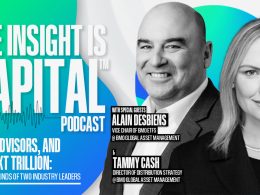by Jamie Hyndman, Mawer Investment Management
Spring has finally arrived in Canada. The grass is green, the flowers are in bloom, and backyard barbecues are just around the corner. While the pleasures of spring are many, it’s not all good. There will be rain, there’s yard work to be done, and it’s the start of road construction season. Yet because these minor negatives are completely expected, they become more tolerable.
Like the ups and downs of spring, bull markets will also have their fair share of setbacks. The recent U.S. market experience makes this all too clear. The Dow Jones Index bottomed at 6,547 on March 9, 2009 and has since recovered to the 15,000 range, an increase of well over 100%. Supporting this increase has been a broad improvement in the underlying economy; economic indicators such as GDP growth, a rise in employment, and a rebound in the housing market, all validate the move.
However, the uninterrupted advance in the U.S. stock market has stalled lately. This is probably because of a new word that has entered our financial lexicon, tapering, which refers to the scaling back of the Fed’s $85 billion in monthly purchases of U.S. bonds. The word first appears to have been uttered back in February in an interview with St. Louis Fed President, James Bullard, in which he said, “We should think about tapering or adjusting the program.” It took a while for his comment to become popularized, but over the past few months, bond yields have moved higher and stoked fears that the end of the equity bull market is nigh.
While volatility is almost sure to increase in this next stage of economic healing, we’re not convinced that an approximate 50 basis point move in yields is going to cause consumers to stop borrowing and investors to switch en masse to bonds. Although the move is significant, it is off such a low base that the absolute level of yields continues to be very low. Also, if yields are increasing at the same time that the economy is strengthening, that is not too troubling. If yields were rising while the economy was weakening, it would be much more concerning.
In addition to being a modest change, rising yields are also not a surprise. The stimulus has to be taken away sometime. That time is when it becomes relatively clear that the economic recovery has firmly taken hold and is self-supporting. The Fed has gone one step further and clarified what it specifically wants to see before dialing back the stimulus – an unemployment rate of 6.5% and an inflation rate of 2.5%. This seems like a reasonable approach as it would indicate general economic health and we would fully expect to see a normalization of yield levels around that time.
Nevertheless, some investors are prone to act on short-term information, such as the words that come out of Fed Chairman Bernanke’s mouth. Such knee-jerk actions can drive the markets higher or lower depending on what’s said. Hence, we do expect continued volatility. To us, though, these are probably just spring showers.
Jamie Hyndman
Copyright © Mawer Investment Management










